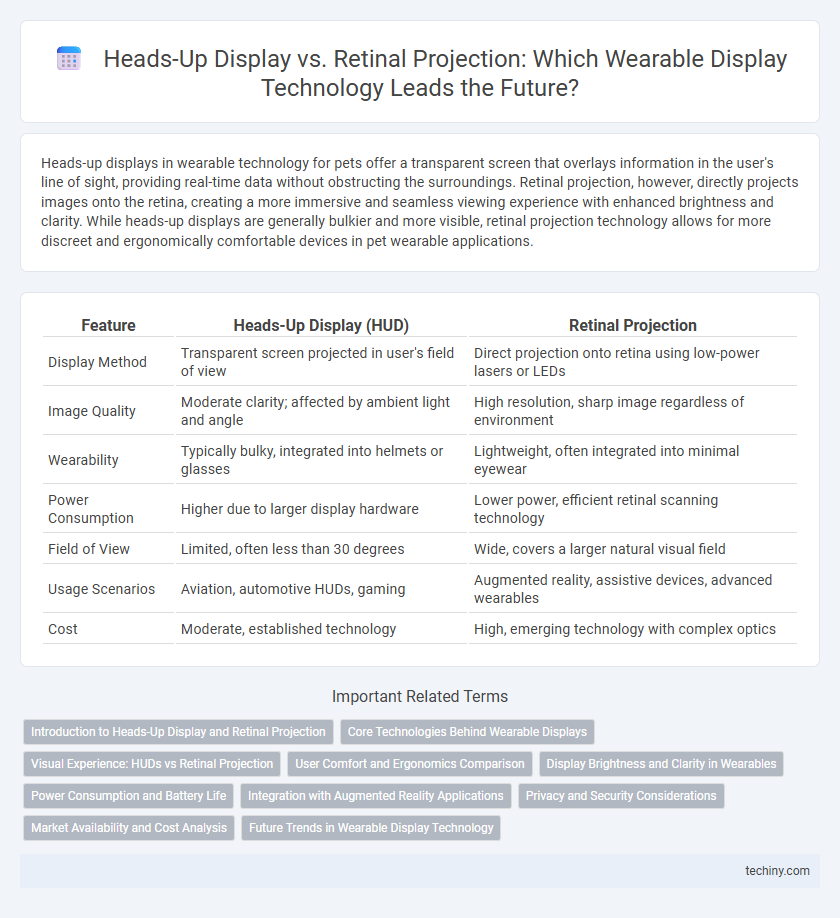Heads-up displays in wearable technology for pets offer a transparent screen that overlays information in the user's line of sight, providing real-time data without obstructing the surroundings. Retinal projection, however, directly projects images onto the retina, creating a more immersive and seamless viewing experience with enhanced brightness and clarity. While heads-up displays are generally bulkier and more visible, retinal projection technology allows for more discreet and ergonomically comfortable devices in pet wearable applications.
Table of Comparison
| Feature | Heads-Up Display (HUD) | Retinal Projection |
|---|---|---|
| Display Method | Transparent screen projected in user's field of view | Direct projection onto retina using low-power lasers or LEDs |
| Image Quality | Moderate clarity; affected by ambient light and angle | High resolution, sharp image regardless of environment |
| Wearability | Typically bulky, integrated into helmets or glasses | Lightweight, often integrated into minimal eyewear |
| Power Consumption | Higher due to larger display hardware | Lower power, efficient retinal scanning technology |
| Field of View | Limited, often less than 30 degrees | Wide, covers a larger natural visual field |
| Usage Scenarios | Aviation, automotive HUDs, gaming | Augmented reality, assistive devices, advanced wearables |
| Cost | Moderate, established technology | High, emerging technology with complex optics |
Introduction to Heads-Up Display and Retinal Projection
Heads-up displays (HUDs) project digital information onto transparent screens within the user's line of sight, enabling hands-free data access without obstructing the real-world view. Retinal projection technology directly beams images onto the retina, offering enhanced visual clarity and reduced eye strain by integrating digital content seamlessly with natural vision. Both technologies serve critical roles in wearable technology, improving situational awareness and user interaction through different optical methods.
Core Technologies Behind Wearable Displays
Heads-up displays in wearable technology rely on waveguide optics and microprojectors to overlay digital information onto transparent surfaces, enabling users to see both real-world and virtual images simultaneously. Retinal projection systems utilize low-power lasers to directly project images onto the retina, offering sharper visuals with reduced eye strain and enhanced privacy. Core technologies behind these displays include advanced light engines, waveguides, eye-tracking sensors, and adaptive optics to optimize image clarity and alignment with natural vision.
Visual Experience: HUDs vs Retinal Projection
Heads-up displays (HUDs) present information directly within the user's line of sight using transparent screens or lenses, offering a clear overlay without obstructing the external environment. Retinal projection technology delivers images by scanning light directly onto the retina, creating a high-resolution, immersive visual experience with enhanced contrast and minimal light spill. The retinal projection provides superior image clarity and depth perception compared to HUDs, making it ideal for complex augmented reality applications.
User Comfort and Ergonomics Comparison
Heads-up displays (HUDs) provide information on transparent screens within the user's line of sight, ensuring minimal eye strain but potentially causing neck fatigue due to head positioning. Retinal projection systems directly project images onto the retina, offering sharper visuals and reducing screen-induced glare, which enhances long-term eye comfort. Ergonomically, retinal projection offers a lighter and less intrusive design, improving wearer comfort during extended use compared to bulkier HUD devices.
Display Brightness and Clarity in Wearables
Heads-up displays in wearable technology offer high brightness suitable for outdoor environments, ensuring clear visibility even under direct sunlight. Retinal projection provides superior image clarity by directly projecting images onto the retina, resulting in sharper and more vivid visuals with minimal distortion. These differences significantly impact user experience, with heads-up displays excelling in brightness and retinal projection delivering enhanced clarity.
Power Consumption and Battery Life
Heads-up displays (HUDs) typically consume more power due to larger projection systems and traditional optics, resulting in shorter battery life for wearable devices. Retinal projection technology uses low-energy lasers to directly stimulate the retina, significantly reducing power consumption and extending battery life. This efficiency makes retinal projection more suitable for prolonged use in wearable tech like augmented reality glasses.
Integration with Augmented Reality Applications
Heads-up displays (HUDs) offer seamless integration with augmented reality (AR) by projecting information onto transparent surfaces, maintaining users' situational awareness while overlaying digital content. Retinal projection technology advances AR integration by directly stimulating the retina, enabling higher resolution, wider field of view, and reduced eye strain compared to traditional HUDs. Both technologies enhance AR applications, but retinal projection provides more immersive and precise visual augmentation for wearable devices.
Privacy and Security Considerations
Heads-up displays (HUDs) often raise privacy concerns due to their external screen visibility, making sensitive information accessible to bystanders, whereas retinal projection offers enhanced security by directly projecting images into the user's eyes, minimizing unauthorized viewing risks. Retinal projection systems reduce data leakage by encrypting the visual feed and limiting exposure to external capture devices, while HUDs require additional safeguards like screen filters to protect user data from visual hacking. Both technologies must integrate robust authentication protocols to prevent unauthorized access, but retinal projection inherently strengthens personal privacy through its discreet delivery method.
Market Availability and Cost Analysis
Heads-up displays (HUDs) are widely available in consumer electronics and automotive sectors, with prices ranging from $200 to $1,000 depending on features and integration level. Retinal projection technology remains in the prototype or limited-release stage, often costing upwards of $2,000 due to advanced optics and laser components. Market availability of retinal projection is constrained by higher production costs and limited manufacturers, while HUDs benefit from established supply chains and mass production economies.
Future Trends in Wearable Display Technology
Future trends in wearable display technology emphasize retinal projection for enhanced resolution and reduced eye strain compared to traditional heads-up displays (HUDs). Retinal projection offers a more immersive user experience by directly stimulating the retina, enabling wider fields of view and brighter visuals in varying ambient light conditions. Advances in micro-LED and laser projection technologies drive the miniaturization and energy efficiency necessary for widespread adoption of retinal projection in smart glasses and AR headsets.
heads-up display vs retinal projection Infographic

 techiny.com
techiny.com